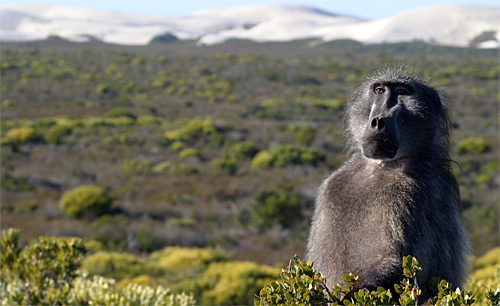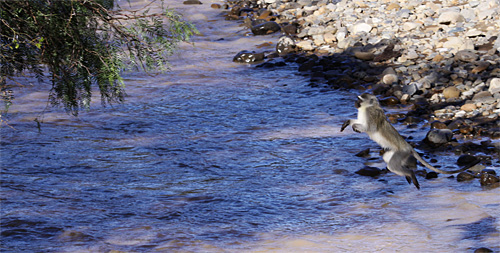Current projects
Monkeys in Space:
Environmental Structure, Behavioural Ecology and Cognition
Funding: NSERC (Canada); NRF (South Africa); Leakey Foundation (USA).
As long-lived, slowly reproducing animals, primates face numerous ecological challenges to survival and successful reproduction. As group-living animals, the social world presents an equally diverse array of challenges that require the negotiation of individual needs within the constraints imposed by others. Most research aimed at defining and identifying the nature of primate social cognition has focussed on the specific demands of the social world, and pays less attention to how environmental and ecological demands interact with these.
Our objective is to take a psychological approach to issues of primate behavioural ecology, where cognitive processes are placed firmly in their ecological context, and where the structure of both the physical and social world has the potential to reduce the cognitive load that animals must bear. More specifically, we consider female social dynamics, sexual conflict and group coordination processes as instances of phenotypically plastic behaviours that have the potential to reveal both the scope and limits of psychologically-based, flexible responses to environmental challenge. Current projects in the field are:
1. The behavioural dynamics of sexual conflict. Do female baboons interact with subordinate males in ways that augment the reproductive concession forced on alpha males by infanticide? Does the smaller
discrepancy in the size of males and female vervets, together with habitat affordances, enable greater female control over mating access -and hence paternity - than is the case for chacma baboons, and does
this then require males to ‘negotiate’ with females? What are the dynamics of male interaction in vervets and how is this structured in the here-and-now?
2. Contingency in decision-making. i. How do baboons and vervets move through their
home ranges in pursuit of resources and to what extent are realised routes a consequence of
environmental structure?
3. Networks...
Field study sites
Our recent baboon field work has taken place at the De Hoop Nature Reserve, in the Western Cape Province of South Africa. De Hoop lies along the coast in a winter rainfall belt and was proclaimed to protect its endemic fynbos plant communities. Its baboons are members of the species' southern-most population and our initial interest in them stemmed from their unusual ecology. Chacma baboons, particularly, are able to occupy a broad range of habitat types - often extreme - and our longer-term goal has been to understand how they manage to do so and with what social sequelae.

Our vervet research has takenplace at two sites, both under the aegis of the Applied Behavioural Ecology and Ecosystems Research Unit (ABEERU) of the University of South Africa. The first - Loskop Dam Nature Reserve - is in Mpumalanga Province, South Africa - and consists primarily of Acacia-Combretum woodland. While our own work there was focused on two groups, allied research projects have habituated a total of six. The second - Samara Game Reserve - is in the Eastern Cape Province and, as befits the karoo, is known, increasingly, for extremes of temperature and scarcity of water. Vervets have penetrated this area along riverine Acacia corridors and the reduced possibility of successful fission has resulted in a population characterised by very large groups whose territories overlap considerably.

